This 7-day clean eating meal plan is perfect for beginners. It focuses on whole foods like fresh produce, lean proteins, and healthy fats. You can choose from 1,500 or 2,000 calorie options to match your goals.
There’s room to swap ingredients or repeat your favorite meals. The plan avoids added sugars and emphasizes nutrient-dense foods like quinoa, tofu, and salmon. Plus, it comes with a printable grocery list to make shopping easier.
Key Takeaways
- Adjustable calorie options: 1,500 or 2,000 calories per day.
- Includes a free printable grocery list for organized shopping.
- Focus on whole foods like vegetables, legumes, and lean proteins.
- Meal prep strategies save time, like batch-cooking grain bowls and vinaigrettes.
- Excludes 1,200-calorie plans to meet recommended nutritional guidelines.
- Flexible substitutions and repeated meals allow for personalization.
What Is Clean Eating? Understanding the Basics
Clean eating is not about being perfect. It’s about feeding your body with real, whole foods. This beginner clean eating guide helps you use unprocessed ingredients for better energy and health. Let’s explore it:
Core Principles of Clean Eating
Here are the basics to get started:
- Choose foods in their natural state (like apples, spinach, and almonds).
- Limit additives like artificial flavors, colors, or preservatives.
- Focus on balanced meals with protein, fiber, and healthy fats.
Foods to Embrace vs. Foods to Limit
| Embrace | Limit |
|---|---|
| Whole grains (quinoa, oats) | White bread, sugary cereals |
| Fresh veggies and fruits | Processed snacks (chips, candy) |
| Lean proteins (chicken, beans) | High-sodium canned soups |
Setting Realistic Expectations
Clean eating is all about being flexible. Use a clean eating shopping list to keep essentials like Greek yogurt or leafy greens on hand. Small changes, like drinking water instead of soda, make a big difference over time. It’s okay to have treats sometimes.
The main goal is to make progress, not to be perfect. Start with one meal and let your choices fit your life. Don’t let your life fit your choices.
Benefits of Following a Clean Eating Meal Plan
Choosing a clean eating plan does more than just improve your nutrition. It changes how you feel and eat every day. The healthy meal prep in this plan gives you steady energy. It balances fiber, protein, and healthy fats.
Think of meals like avocado toast with eggs or a spinach salad with grilled chicken. These meals keep you energized without the afternoon slump.
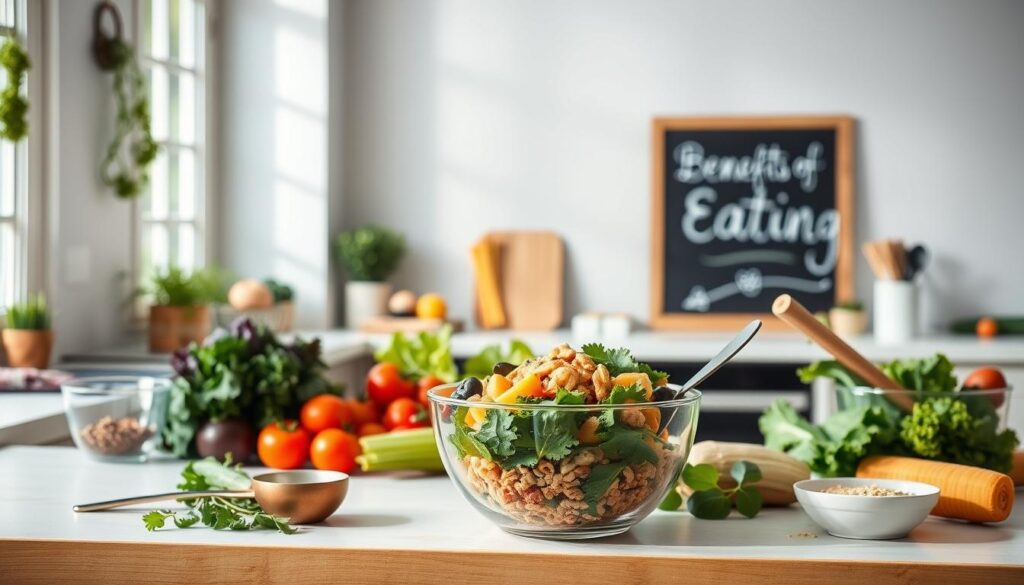
- Energy stability: 89g of daily protein and 36g fiber support sustained energy.
- Heart health: 1,500mg sodium and 14g saturated fat daily align with the American Heart Association’s guidelines.
- Flexibility: Three calorie tiers (1,200–2,000) let you adjust portions to your lifestyle.
“The American Heart Association recommends 1,500mg sodium daily for blood pressure control.”
A printable meal plan makes shopping easier and helps you avoid impulsive choices. With pre-planned meals, you spend less time deciding what to eat. You get to enjoy nourishing foods more.
The plan focuses on whole foods like salmon, quinoa, and leafy greens. This makes it easier to avoid processed snacks.
By reducing decision fatigue and waste, this approach saves money over time. Tips like pre-chopping veggies or marinating proteins make healthy meal prep easier. Small steps like these make clean eating a habit, not a chore.
Your Complete 7-Day Clean Eating Meal Plan with Printable Grocery List
Make your week easier with easy meal planning. This guide offers clean eating recipes and a downloadable grocery list. It ensures every meal is full of whole foods, protein, and fiber. Spend Sunday and Wednesday evenings prepping by chopping, marinating, and cooking ahead.
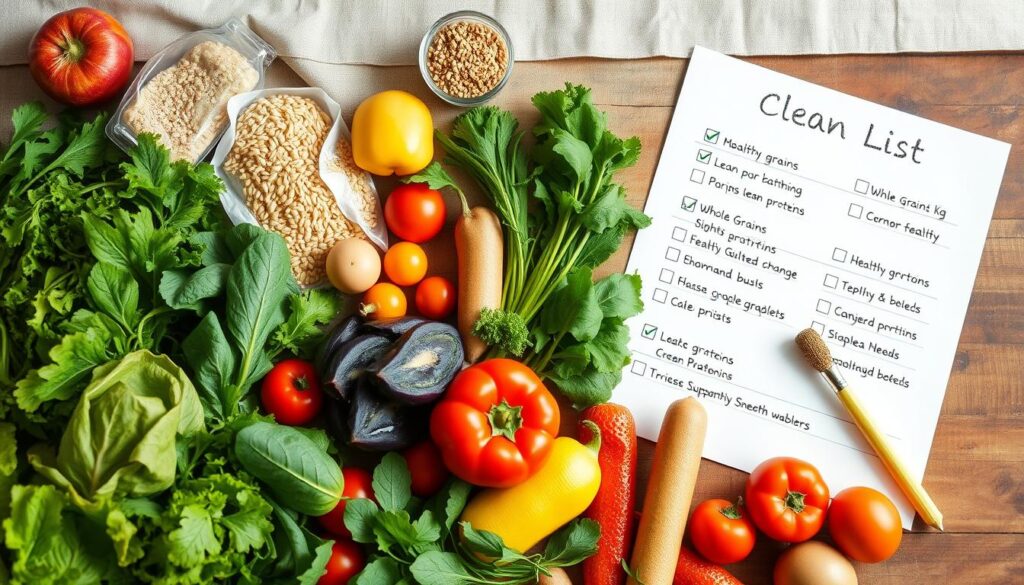
Breakfast Options for the Week
- Yogurt parfaits: Layer 1 cup low-fat Greek yogurt with raspberries, walnuts, and honey-free peanut butter.
- Overnight oats: Mix rolled oats with almond milk and chia seeds; top with apple slices and cinnamon.
- Vegetarian scramble: Sauté spinach, mushrooms, and tofu with turmeric for a savory plant-based start.
Nutritious Lunch Ideas
Keep your energy up with these easy-to-carry options:
- Quinoa bowls with roasted veggies, chickpeas, and tahini dressing
- Grilled chicken wraps in whole-wheat tortillas with avocado and salsa
- Salads packed with kale, grilled shrimp, and a lemon-balsamic vinaigrette
Healthy Dinner Recipes
Enjoy family-friendly meals with seasonal ingredients:
- Pan-seared salmon with asparagus and barley pilaf
- Zucchini noodles tossed with pesto and sun-dried tomatoes
- Black bean tacos with roasted sweet potatoes and cilantro lime crema
Clean Snacks and Treats
Keep cravings at bay with these healthy snacks:
- Apple slices dipped in peanut butter
- Cucumber chips with hummus
- Dark chocolate (70%+) paired with berries
Download the free PDF for the full meal plan, shopping list, and 80/20 flexibility tips. Swap proteins or grains to match your taste while staying true to whole foods.
Day-by-Day Breakdown of Your Meal Plan
Follow this printable meal plan for a structured yet flexible approach to clean eating. Each day’s meals are designed with easy meal planning in mind. They balance protein, fiber, and whole foods. Start by downloading the plan and adjust portions based on your family’s needs.
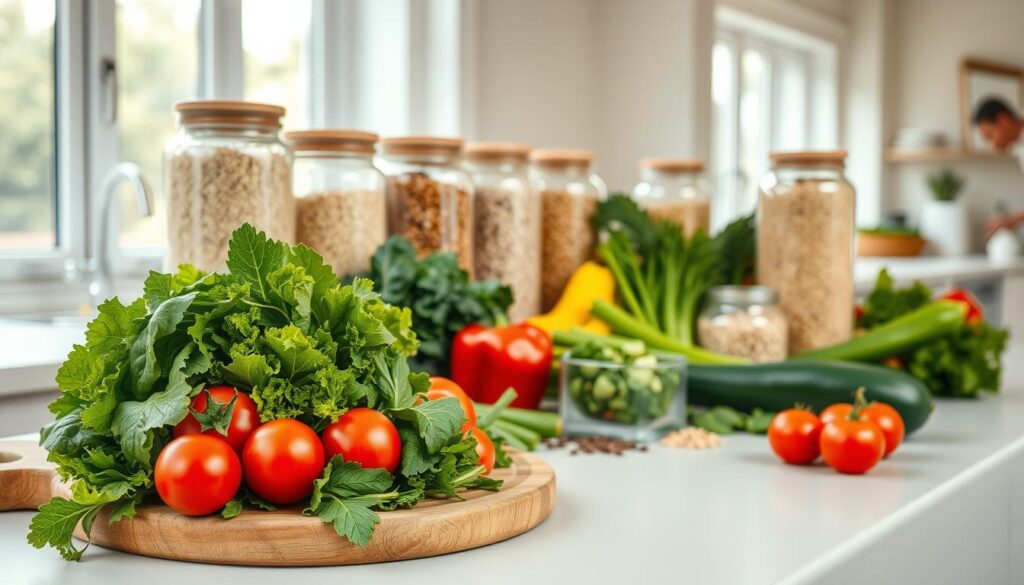
Monday through Wednesday Meals
- Monday: Creamy millet with blueberries & almonds (39g protein at breakfast) pairs with green salads (27g protein) and black bean soup (26g protein).
- Tuesday: Try yogurt parfaits (39g or 12g protein) and baked salmon lunches (27g-38g protein).
- Wednesday: Use leftovers from prior meals to streamline prep, like repurposing roasted veggies in wraps.
Thursday through Sunday Meal Ideas
- Thursday: Opt for turkey-based dishes like smoky beans and baked eggs (21g protein) or falafel wraps.
- Friday: Enjoy salmon or cod with quinoa (38g protein) and steamed greens.
- Saturday-Sunday: Weekend meals include pulled pork tacos (29.7g protein) and frozen-friendly options like mac ‘n’ cheese.
Portion Guidance and Modifications
Base meals on 1,500 calories. For 2,000 calories, add ½ cup yogurt and ⅓ cup almonds daily. The 2020 Dietary Guidelines note 1,200 calories may fall short for most adults. Adjust portions using the printable meal plan’s flexibility—swap proteins like tofu for chicken or use frozen veggies to save time.
“Meal prepping weekends ensures weekday meals take 20 minutes or less.”
Recipes like curry hummus or banana ice cream can be doubled and frozen. Use whole packets of ingredients to minimize waste. All meals align with clean eating principles, using methods like baking or steaming to preserve nutrients.
Shopping Smart: How to Use the Printable Grocery List
Make the most of your clean eating journey with the grocery list template designed for your 7-day plan. Organize your shopping by categories like produce, proteins, and grains. This makes shopping faster and helps you not miss anything.
Before you go, check what you already have at home. This saves money and reduces waste.
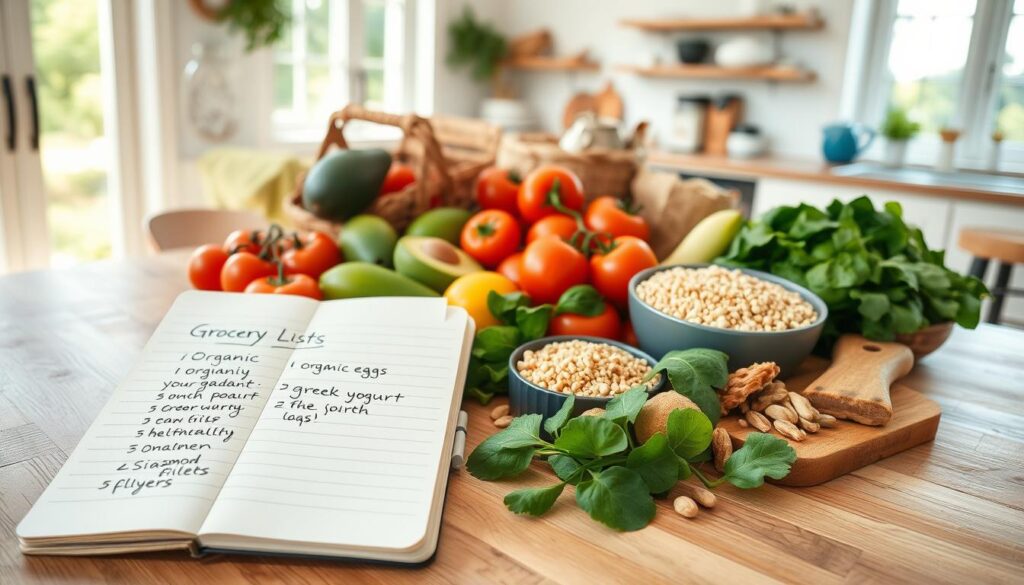
Use the clean eating shopping list to focus on seasonal produce. The USDA Seasonal Produce Guide helps you find affordable, fresh options. For example, winter squash in fall or berries in summer.
Choose budget-friendly proteins like canned tuna, chicken thighs, or lentils. Frozen veggies and fruits without added sugar are great any time.
- Label-reading pro tip: Pick canned beans with no salt and tomato sauce without sugar. Look for grains like quinoa or oats with few ingredients.
- Stay on track! Avoid impulse buys. Use the template to note quantities and trusted brands.
- Customize your grocery list template by swapping items. For instance, swap salmon with cod if it’s cheaper, or use spinach instead of kale.
For more savings, follow the USDA’s MyPlate tips on buying in bulk and storing food. With this clean eating shopping list, you can save 30% on meals while staying on track with your nutrition goals. Adjust portions and items as you see fit—your wallet and plate will appreciate it!
Meal Prep Strategies for Clean Eating Success
Mastering healthy meal prep keeps your clean eating plan on track. Spend 1–2 hours each weekend prepping ingredients. This saves 2 hours weekly and $50 monthly. Batch-cook proteins like baked chicken or lentils, chop veggies, and store dressings like Citrus Vinaigrette. Meal prep ideas like Vegan Superfood Grain Bowls or One-Pot Chicken & Rice Soup make busy days easier. Here’s how to set yourself up for success:
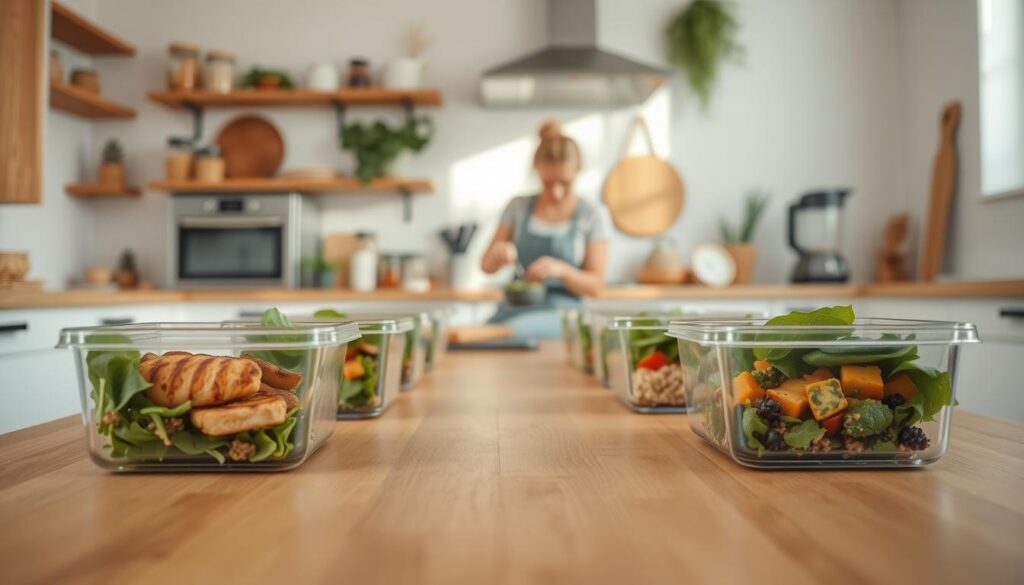
- Roast grains like quinoa and farro in bulk
- Cook proteins (salmon, turkey, or tofu) for quick meals
- Pre-chop veggies and store in airtight containers
- Prep grab-and-go snacks like pre-portioned nuts or veggie sticks
Storage Solutions:
- Use glass containers for freshness and microwave safety
- Freeze prepped veggies or proteins in labeled bags
- Organize fridge with dedicated zones for grains, proteins, and veggies
Time-Saving Hacks:
- Cook soups or chili in a slow cooker overnight
- Buy pre-cut veggies from stores like Trader Joe’s
- Keep a food processor for quick pesto or hummus
Even small steps count! Prep just one component weekly—like marinating chicken or prepping a grain base—to ease into consistent healthy meal prep. Every minute saved now means less stress later.
Common Clean Eating Challenges and How to Overcome Them
Following a 7-day clean eating meal plan with printable grocery list can be tough. We’ll face real challenges with easy fixes. This way, you can keep up without feeling overwhelmed.
“Don’t ignore cravings—enjoy them mindfully. A small treat fits into a balanced approach.”
Eating Out Without Compromising
Opt for grilled proteins, salads with olive oil, and steamed veggies. Ask for sauces on the side or for brown rice instead of pasta. Say things like: “Can I have this without added sugar?” or “Is there a plant-based option?”
Cravings? Navigate Them Wisely
- Plan one weekly treat (dark chocolate, fruit smoothie) to satisfy desires without derailing progress.
- Stay hydrated—thirst is often mistaken for hunger.
- Use the beginner clean eating guide to swap chips for roasted chickpeas or kale chips.
Adapting for Your Needs
See the 7-day clean eating meal plan as a guide, not a strict rule. For dietary needs:
- Swap meat for tofu or lentils in recipes.
- Check the grocery list for gluten-free swaps like quinoa or buckwheat.
- Refer to the beginner guide’s flexibility tips for allergies or preferences.
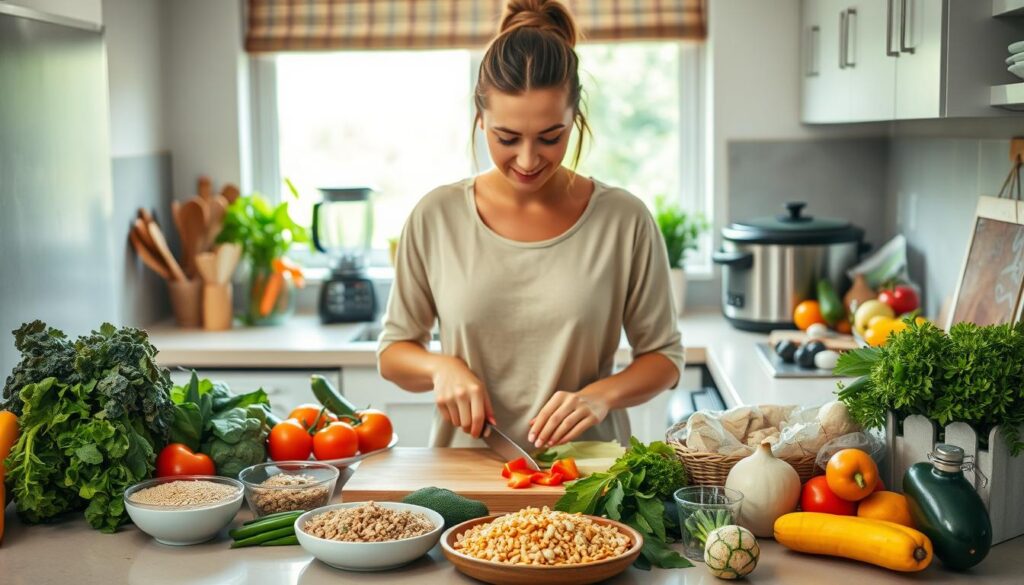
Clean eating isn’t about being perfect. The beginner clean eating guide offers substitutions and tips for adapting. Start with small steps, like the 7-day Junk to Superfoods Challenge. Stay hydrated, rest, and celebrate your small victories. Being flexible is key to success!
Budget-Friendly Tips for Clean Eating
Starting clean eating doesn’t mean you have to spend a lot. Focus on meal prep ideas with affordable items like lentils, frozen veggies, and canned beans. A USDA report says families spend $8,000 a year on food. With smart planning, you can cut this cost without losing nutrition.
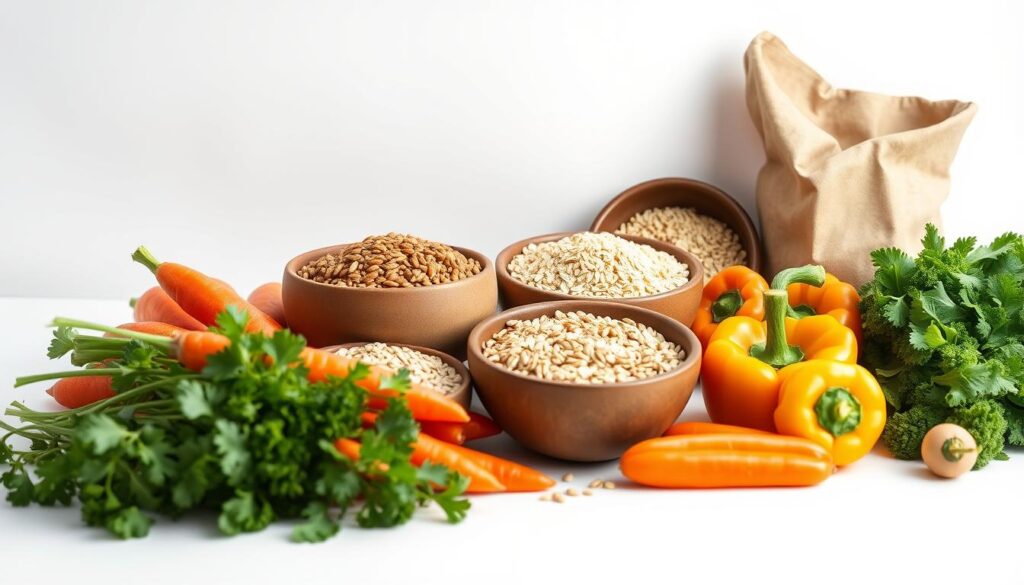
- Buy seasonal produce at farmers’ markets or discount bins. Frozen veggies and fruits are often cheaper and just as nutritious.
- Swap expensive proteins: Use eggs, beans, or tofu in clean eating recipes like lentil soups or black bean tacos.
- Stock bulk staples like quinoa, brown rice, and oats from stores like Walmart or Costco.
- Repurpose leftovers—transform roasted veggies into frittatas or stir-fries.
| Ingredient | Cost Per Serving | Meal Prep Ideas |
|---|---|---|
| Canned beans | $0.35 | Salads, chili, tacos |
| Frozen spinach | $0.40 | Pasta dishes, smoothies |
| Eggs | $0.20 | Omelets, frittatas, salads |
Choose store brands for pantry items—Walmart’s Great Value and Aldi’s products often match name brands. Compare unit prices and buy family-sized packages to cut costs. With these strategies, a 7-day plan costs under $112, showing clean eating is possible on any budget. Small changes like meal prepping or freezing leftovers can lead to big savings without losing flavor or nutrition.
Conclusion: Sustainable Clean Eating Beyond the 7-Day Plan
The 7-day meal plan is just the start. It’s about making whole foods and mindful choices a part of your life. The clean eating shopping list and recipes help you create your own path, not strict rules.
Listen to what you like while choosing foods that are good for you. Feel free to change ingredients, try new veggies, or adjust portions. Small changes can lead to big benefits, like a 11% lower risk of chronic disease and 10 pounds lost in six months.
It’s okay to enjoy treats now and then. Swap sugary cereals for oatmeal with honey, for example. This way, you can enjoy your food without feeling guilty.
Life can be unpredictable, so be flexible. Use apps to track your progress and AI meal planners for dietary needs. The 14-day sample plan shows you can mix things up—try quinoa bowls one night and zucchini noodles another. Even on busy days, prep grains and proteins ahead to stay on track.
Don’t aim for perfection. Keep the clean eating shopping list for grocery trips and try new seasonal produce. Clean eating is about nourishing your body and enjoying food. With these tips, you’re set to create a sustainable routine that suits you, one meal at a time.



